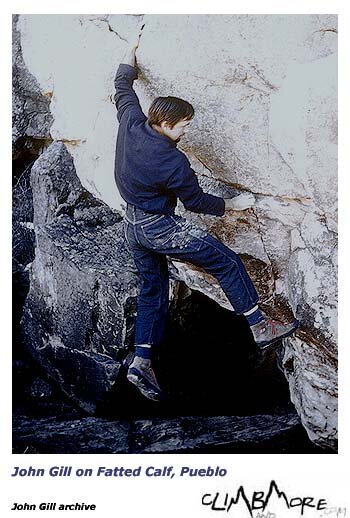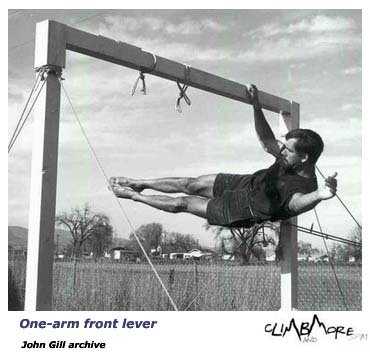John Gill on Training

ClimbAndMore: You probably agree with the old saying that the best training for climbing is the climbing itself, don’t you?
John Gill: Yes, I suspect it is.
Do you agree that focusing too much on training may be detrimental to your climbing, as training itself may then become your primary objective?
That may not be a bad thing. Look at the martial arts and the focus on katas. There's nothing dangerous about finding joy in physical exercise - in focus and concentration - even if it leads you astray.
Did you also train on the days when you climbed, or did you rock climb and train on different days? And how do you estimate the ratio between your climbing and training days throughout all phases of your career?
No, I trained on days I did not climb. When I was in the Air Force or living down south, and could not get out to the rock, training became very important. Otherwise, I would have quit climbing.
John Bachar studied kinesiology books, which gathered experience from different sports and tried to apply that experience to climbing. Did you do it, too? I mean, it’s obvious that you used your gymnastic experience in climbing. But were you interested in the theory of sport training in general?
Not particularly.
Can you say now, after years, that you made some mistakes in your climbing training? If yes, which would you point out as the biggest one?
I would say the things I did were appropriate for me. I did not want to be only a climber. I wanted to have the experience in doing some hard gymnastics, and I wanted to build up my physique. For the levels of difficulty in climbing these days, this approach would not be very effective if you want to be only a climber. Big muscles are not required. Good genetics is. Lightness is a blessing.
Are you still interested in the science of climbing training; do you read any books about it etc? Is it interesting for you how your ideas have evolved and whether current specialists agree with your ideas?
It's all become very scientific. I may have introduced the idea of specific training regimens to many American climbers, but others have refined training techniques to a remarkable degree. Since I no longer push myself in training – I merely try to keep from deteriorating too fast! – I don't have a strong interest in new training ideas.
Which of your strength tricks do you consider the most difficult to repeat for others?
The one-arm front lever, the one-finger pull-up, and the one-arm pull-up on a ½ ledge. Take your pick.

How long were you able to keep your one-arm front lever?
About 3 seconds. I quit doing it years ago.
When did you start feeling that you were losing your strength or gymnastic ability? Which is the first to go away with age?
Well, it's not necessarily the fingers that go first. Watch out for your shoulders and back. I'm pretty banged up but fortunately I still can climb a bit! You lose when you don't keep practicing. This can start as early as your late 30s. If you don't want to lose it, keep doing it!
Have you noticed the changes in the climbing technique throughout the years? It seems that the biggest change occurred when artificial climbing walls became popular. When I look at your pictures, it seems that twisting was not popular in your time. It seems that you often climbed overhangs frontally, didn’t you?
Good point. I never thought of that! If I had been skinnier, maybe I would have done more twisting! As it was, turning sideways would have probably pushed me away from the rock. Twisting or high heel hooks, which I didn't use either, seemed a little too simian for my tastes! Remember, I had a peculiar agenda that did not focus entirely on getting up problems that others could not. What felt kinaesthetic was what I liked to do. Contorting into a yoga position on the rock just to get up didn't appeal to me.
Have you ever tried visualization techinques for your climbing or gymnastic training on a larger scale? I mean, have you visualized particular climbing sequences or gymnastic exercises to prepare mentally for the real performance?
I did meditative exercises in the late 1950s and early 1960s. Initially I wanted to improve my abilities, but a greater benefit was an increased sense of pleasure at any level of difficulty.
“If you really want to achieve your maximum, you’re going to end up getting injured – tendenitis, stuff like that. As soon as you do it once, you heal yourself, then you’re going to know a little bit more where your limit is” – said John Bachar. Do you agree? Do you think you could have avoided your injuries or were they rather inevitable?
As an old man, I would have to advise caution when pushing oneself. Every injury you incur will come back to haunt you in later years.
Did you completely give up climbing and physical activity in the periods when you suffered from serious injuries? Or did you do some easy climbing or hiking etc.?
Just some hiking. I got back into climbing slowly and cautiously.
Do you still do strength exercises, or do you rather concentrate on climbing now? If you still work out (which I suppose you do), which exercises do you do now?
I still do some exercises in my garage gym. Climbing up inverted ladders, etc. I can still do a pure hanging, hand traverse across a 3meter,1.5 cm. ledge, so my grip is pretty good for an old codger.
To finish this part, could you give our readers some general advice on training?
Each of you is unique. Experiment and find what works best for you. Don't think that the one-size-fits-all approach of some books or gurus will necessarily be best for you. And have some fun training – make it a ritual and a game. Be sure to have frequent rest days, and don't overstress those small tendons. Gain your strength gradually and safely. Good Luck!
|